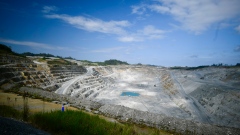May 8, 2024
EU Backs Plan to Tap Profits From Russian Assets to Aid Ukraine
, Bloomberg News
(Bloomberg) -- European Union member states have tentatively approved a plan to use the profits generated by Russian sovereign assets frozen in the bloc to support Ukraine’s recovery and military defense.
Under the plan agreed to by EU ambassadors on Wednesday, most of the proceeds generated from Feb. 15 onwards would be transferred to the European Peace Facility, a mechanism that reimburses weapons supplied to Kyiv, and to the EU budget’s Ukraine facility.
The agreement comes after months of haggling between member states amid worries about possible legal challenges, retaliation from Russia and risk to the stability of the euro. It now needs to be formally adopted by member states.
About $280 billion in assets have been immobilized by the Group of Seven nations since Russia’s 2022 invasion of Ukraine, with more than two-thirds of those held in the EU. The vast majority of the funds has been held through the Belgium-based settlement giant Euroclear, where they have generated about €3.9 billion in net profit since last year.
Some €159 billion of frozen Russian assets have generated a net profit of €557 million ($601 million) from that date, according to Euroclear’s first quarter financial results.
Profits generated prior to Feb. 15 will be retained by the clearing house to manage any risks such as those stemming from court cases. The plans include an emergency mechanism to release more funds should the costs of those risks balloon.
Separately, US-led discussions are ongoing within the G-7 to advance the value the profits will generate over time in order to make more funding available to Ukraine faster, Bloomberg previously reported. The US is pushing to have an agreement when G-7 leaders meet in Italy in June.
Some allies still need convincing though to take additional steps that go beyond what the EU agreed to this week. Several EU nations, including Germany and France, have been opposed to moves to seize the assets outright, while others, like Estonia, have pushed for bolder action.
--With assistance from Alberto Nardelli.
©2024 Bloomberg L.P.








